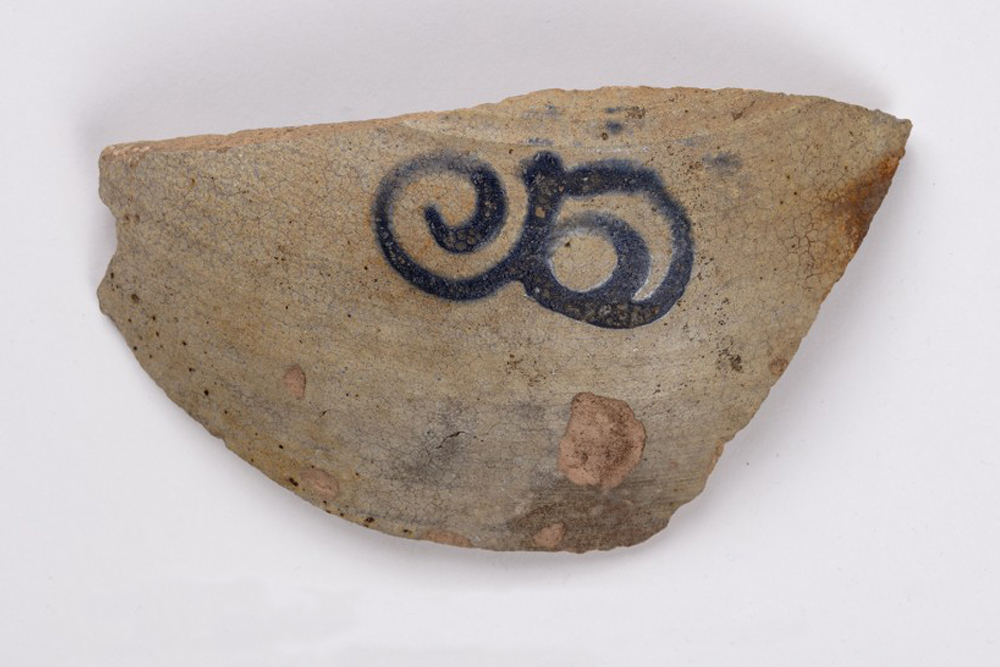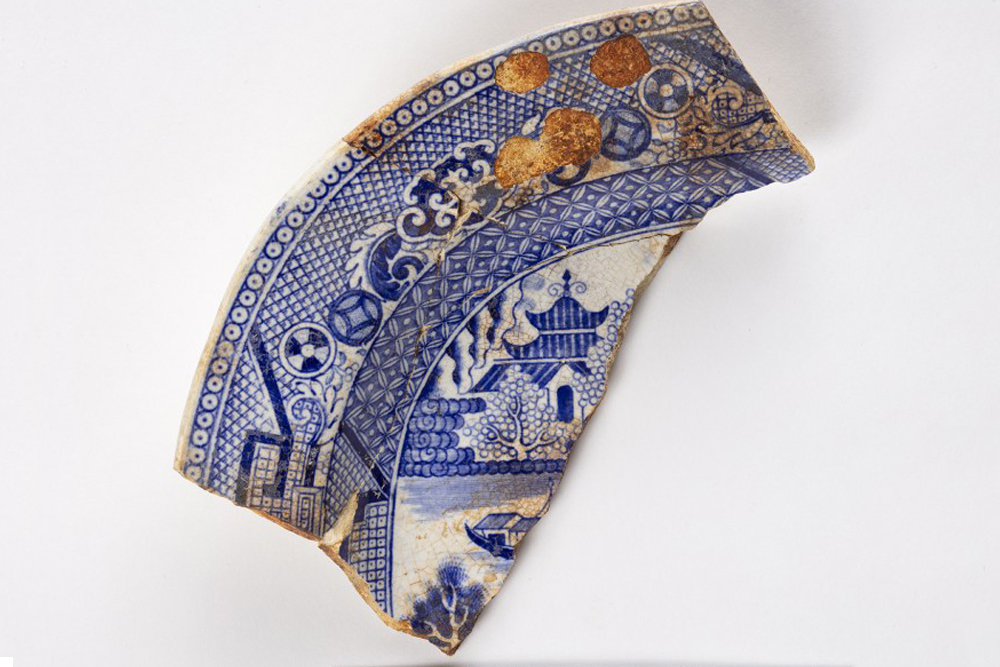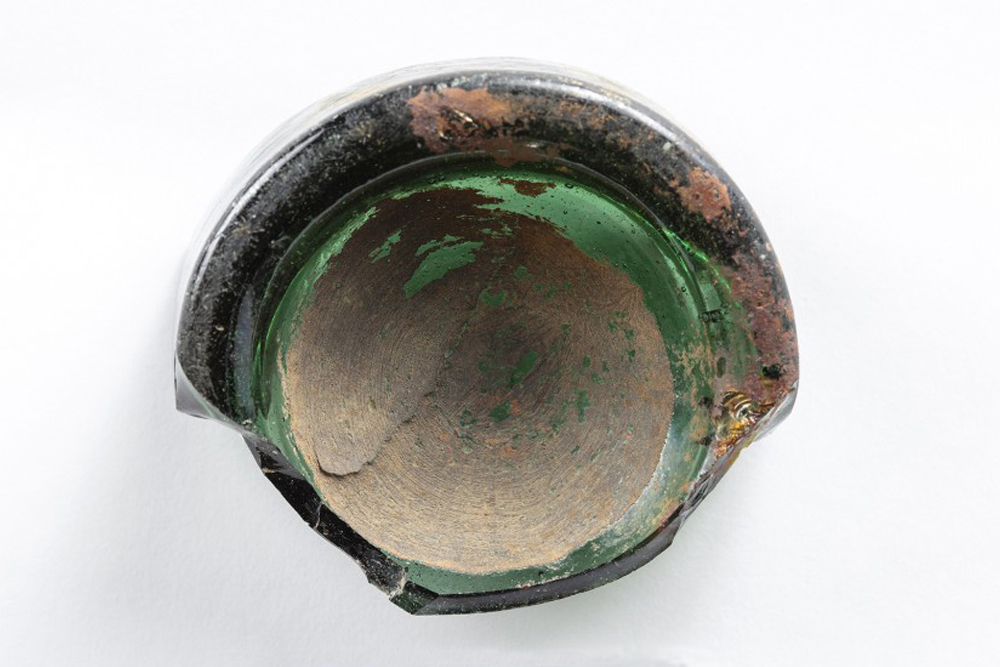Jug
Seneca Village was predominantly a Black middle class neighborhood which was located where the city of New York subsequently built Central Park. Through the excavation of Seneca Village and the sites of houses like that of the Wilson family–where this stoneware jug was found– historians, archeologists, and students alike have the opportunity to learn more about the history of New York City and its Central Park.
History and Form of Jugs
The word “jug” connotes more than just the common container used for holding liquids such as beer, cream, milk, and water used in the kitchen and for cleaning the body. Did you know the term “jug” also refers to a nickname for the female name Joan, according to the Oxford English Dictionary? It was also used to represent the calling of a nightingale as a musical note, and was even another term for “prison” in the nineteenth century. Jugs are quotidian objects, incredibly useful because of their versatility as well as their variety of shapes and sizes. Although there are multiple types of jugs, including jugs for molasses, syrup, and leach (the different forms of which are depicted in Figure 1), the most common was the molasses jug, which had a beehive or ovoid shape, a long neck, and a small opening. An example is the vessel at the far left of Figure 1. In the nineteenth century, jugs served a vital role in daily life, specifically in the kitchen for retrieving water while cooking (Ketchum 1991, 13). The most important use of jugs and stoneware vessels in general was as food and beverage storage. This is because of their impermeability, durability, and variety of sizes, ranging from a small pint to a multiple-gallon receptacle. In addition to being able to store dairy products like milk and cream because of their airtightness, stoneware products could also hold household items such as vinegar, cider, sauerkraut, and other acrid commodities since they are acid resistant (Greer 2005, 16). The jugs mostly likely had a stopper that was placed in the opening to protect the contents. Fragments of this historical vessel were found throughout the excavation, to which I will turn now.

Figure 1: This image portrays three main types of jugs produced in stoneware kilns during the nineteenth century in the United States. (Courtesy of Chemung County Historical Society)
Background
Found in Seneca Village, the ceramic shard that I have been researching provides an insight into the material culture of the Wilson family and, by extension, others who lived in this interracial neighborhood in nineteenth-century New York City. By “material culture,” I mean an interpretation of society which can be studied through the objects and architecture used and created by humans. By studying this shard, we can understand the kinds of foods, flavors, and nutritional matter that the villagers consumed on a daily basis. This fragment is all that remains of a stoneware jug made with a salt glaze and a cobalt spiral decoration. It was found in the foundations of the Wilson family home and between pieces of flat iron sheeting that was most likely used for their roof. A middle class African American family, the Wilsons owned the land they resided on and there were a number of stoneware objects in their archaeological assemblage. According to the 1850 New York State Census, William Godfrey Wilson, the head of his household, was a porter who was Black and owned enough property to vote. Like most of the other Seneca Villagers, the census indicates he and his family were literate, meaning they likely valued education. According to Cynthia Copeland, the Village created a school in the Church to give their children access to knowledge and social mobility. Women in the nineteenth century were not allowed to own property, but, as stated by the 1855 New York State Census, several African American women owned land despite this, perhaps as a subtle mode of resistance to the eventual erosion of Black ownership. Furthermore, women took on the job of cooking and maintaining the household, which is why Sally Wilson would have likely been the person who used this stoneware jug along with other kitchen objects. Moreover, this jug would have been an essential part of the Wilson kitchen for the use of Mrs. Wilson, who might have prepared foods or beverages to store within it.
Stoneware Ceramic
The defining attributes of this shard include its water-spring design and the materials of which it is made–special clays, salt, and cobalt. This type of stoneware was produced first in Europe and then in many places in American colonies, including New York, New Jersey, Pennsylvania, and Virginia, beginning in 1720 (Maryland Archaeological Conservation Laboratory, 2015). During this time period in New York City, jugs were used both in households and taverns because of their functionality and relative affordability. The qualities of stoneware ceramics, such as the hard and dense nature of the clay and its imperviousness, allowing the firing of the pottery at a high heat without the loss of its shape, made it more useful than ceramics made of earthenware.

Figure 2: The salt-glazed stoneware ceramic shard depicts a water-spring design. (Photo courtesy of the NYC Archeological Repository)
Production
My artifact, seen in Figure 2, is a piece of North American stoneware made using the “wheel-thrown” technique. This means that the potter would have used a wheel, which was likely made of wood and used by a potter in a standing position with a rotary that was turned manually via a foot pedal. The phrase “throw upon the wheel,” portrayed in Figure 3, refers to the shaping of the clay into an object from the moment the clay is on the wheel until it is removed (Greer 2005, 33).
In the broader context of the city, stoneware jugs were not industrially produced, but made by artisan potters who worked mainly in a domestic setting and passed on their skills to their sons and apprentices. This tradition was inspired by guilds in the 1600s in Europe that were characterized by the sharing of skills such as pottery creation, between artisans and apprentices alike (Janowitz 2008). The design was often created by the potter, rather than determined by a specific workshop or kiln. Instead, the maker’s mark would identify the workshops and/or kilns that made a particular stoneware object, including both utilitarian and “special pieces” (Janowitz 2008). Decorations or designs were hand painted by potters, and special pieces were more ornately decorated than vessels made for everyday use, such as stoneware jugs or jars. A jar is different from a jug because of the size of the opening. Whereas a jug has a smaller neck, a jar is wider and has more versatility for storing foods. The design on the ceramic object often helped in identifying the level of artistic skill and mastery the potter possessed. The decoration was often etched onto the ceramic object and brushed with a cobalt solution before placing the salt glaze overtop (Greer 2005, 18). Jugs which were well made could last a very long time, though this depended on the skill of the potter who produced the vessel.

Figure 3: The image here demonstrates how a potter uses a wheel and clay to create a ceramic vessel (Photo courtesy of The Chipstone Foundation)
Present Significance
In a city like New York, jugs are still commonly used, though they have changed somewhat in material and shape. In the kitchen, we have plastic gallon-sized milk jugs and glass jugs for other liquids such as juice and water, highlighting the connection between the form of the objects and the different materials used in the past versus the present. The form of a jug is very particular, with a “long neck” and wide “belly” as well as a smaller handle used to carry the jug and as an aid for holding and pouring (Greer 2005, 20). A jug typically did not store wine, but in the Wilson family assemblage a glass bottle indicated that they may have drank alcohol such as wine, in addition to the beer and cider that commonly was stored in jugs.
The object fragment has a remarkable history and prominence, considering the attributes of the stoneware ceramic and the versatility of this vessel. This simple shard tells us the story of Seneca Village’s material culture in New York and sheds light on the African American landowners who lived there.
Works Cited
Doane, Erin. 18 Apr, 2016. “Farrington stoneware.” Chemung County Historical Society (blog). http://chemungcountyhistoricalsociety.blogspot.com/2016/04/farrington-stoneware.html.
Greer, Georgeanna H. 2005. American Stonewares: The Art And Craft of Utilitarian Potters. Atglen, Pennsylvania: Schiffer Pub Ltd.
Janowitz, Meta F. 2008. “New York City Stonewares from the African Burial Ground.” Ceramics in America 2008. Chipstone. http://www.chipstone.org/article.php/412/Ceramics-in-America-2008/New-York-City-Stonewares-from-the-African-Burial-Ground.
Jefferson Patterson Park & Museum. 26 Oct, 2015. “Diagnostic Artifacts in Maryland.” https://apps.jefpat.maryland.gov/diagnostic/Post-Colonial%20Ceramics/NorthAmericanStoneware/index-NorthAmericanStoneware.html.
Ketchum, Jr., William C. 1991. American Stoneware. New York: Henry Holt and Company, Inc.
New York City Archaeological Repository: The Nan A. Rothschild Research Center. 2020. “Seneca Village.” NYC Landmarks Preservation Commission, New York, NY. http://archaeology.cityofnewyork.us/collection/map/seneca-village.
New York State Census (NYSC). 1850. Census Returns for the Sixth Ward of the City of New York in the County of New York. Manuscript, Department of Records and Information, Municipal archives of the City of New York, New York, NY.
New York State Census (NYSC). 1855. Census Returns for the Sixth Ward of the City of New York in the County of New York. Manuscript, Department of Records and Information, Municipal archives of the City of New York, New York, NY.
Newell, Mark M., and Peter Lenzo. 31 Dec, 2006. “Making Faces: Archaeological Evidence of African-American Face Jug Production.” Chipstone. http://www.chipstone.org/article.php/287/Ceramics-in-America-2006/Making-Faces:-Archaeological-Evidence-of-African-American-Face-Jug-Production.




